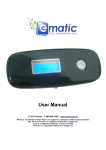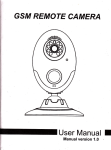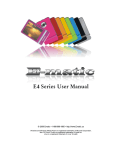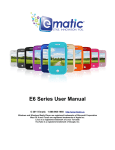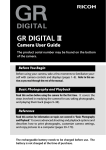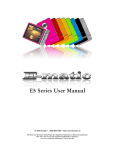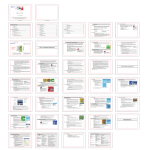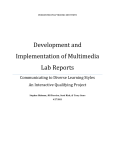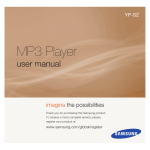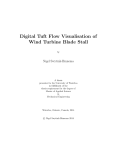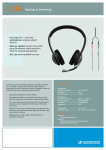Download Ematic: Esport Clip User Manual
Transcript
eSport Clip User Manual © 2011 Ematic ● 1-888-968-1985 ● http://www.Ematic.us Windows and Windows Media Player are registered trademarks of Microsoft Corporation Mac OS X and iTunes are registered trademarks of Apple Inc. Linux is a registered trademark of Linus Torvalds eSport Clip User Manual Table of Contents 1.0 Introduction ............................................................................................................................... 1 1.1 Foreword ....................................................................................................................... 1 1.2 Package Contents ........................................................................................................ 1 1.3 Warnings....................................................................................................................... 1 1.4 Computer Requirements .............................................................................................. 1 1.5 Layout of the Player...................................................................................................... 2 Part I: Computer Operations 2.0 Connecting and Charging the Player ....................................................................................... 3 2.1 Connecting and Disconnecting the Player from Your Computer ................................. 3 Charging the Battery .................................................................................................... 3 Video Conversion ...................................................................................................................... 4 2.2 3.0 Converting Video .......................................................................................................... 4 3.2 Using Other Conversion Software ................................................................................ 4 3.3 Converting Video in Linux ............................................................................................. 5 Copying Files ............................................................................................................................. 6 4.1 Copying Media Files to Your Player .............................................................................. 6 4.2 Using Windows Media Player Sync Function ............................................................... 6 Expanding the Player's Storage ................................................................................................ 7 5.1 Preparing MicroSD Cards for Use ................................................................................ 7 3.1 4.0 5.0 Part II: Player Operations 6.0 7.0 8.0 Basic Operations ....................................................................................................................... 9 6.1 Turning the Player On and Off ...................................................................................... 9 6.2 Navigating Menus ......................................................................................................... 9 6.3 Changing the Volume .................................................................................................. 10 Watching Videos ...................................................................................................................... 11 7.1 Playing a Video ........................................................................................................... 11 7.2 Basic Play Operations ................................................................................................. 11 7.3 Video Menu Commands ............................................................................................. 11 7.4 File Menu Commands ................................................................................................. 11 Listening to Audio .................................................................................................................... 12 8.1 Playing an Audio File .................................................................................................. 12 8.2 Basic Play Operations ................................................................................................. 12 eSport Clip User Manual 9.0 10.0 11.0 12.0 13.0 14.0 15.0 8.3 Audio Menu Commands ............................................................................................. 12 8.4 File Menu Commands ................................................................................................. 12 Viewing Pictures ...................................................................................................................... 13 9.1 Entering Pictures Mode............................................................................................... 13 9.2 Basic Play Operations ................................................................................................. 13 9.3 My Pictures Menu Commands .................................................................................... 14 Shooting Photographs ............................................................................................................. 14 10.1 Entering Camera Mode ............................................................................................... 14 10.2 Basic Photo Shooting Operations ............................................................................... 14 10.3 Camera Menu Commands .......................................................................................... 14 Video Recorder ........................................................................................................................ 15 11.1 Entering Video Recorder Mode................................................................................... 15 11.2 Basic Video Shooting Operations ............................................................................... 15 11.3 The Video Recorder Menu .......................................................................................... 15 Recording Audio ...................................................................................................................... 15 12.1 Entering Recordings Mode ......................................................................................... 15 12.2 Basic Recorder Operations ......................................................................................... 15 Listening to the FM Radio ....................................................................................................... 16 13.1 Entering Recordings Mode ......................................................................................... 16 13.2 Basic Radio Operations .............................................................................................. 16 Ebook Operations .................................................................................................................... 17 14.1 Entering eBook Mode ................................................................................................. 17 14.2 File Operations ............................................................................................................ 17 Tools 15.1 16.0 Accessing the Tools .................................................................................................... 18 Settings .................................................................................................................................... 19 Miscellaneous 17.0 Help 17.1 Troubleshooting........................................................................................................... 21 17.2 For More Help ............................................................................................................. 21 18.0 Technical Specifications .......................................................................................................... 22 eSport Clip User Manual 1.0 Introduction 1.1 Foreword Thank you for purchasing this player. Please read this manual carefully before using the product. Specifications and software updates are subject to change without notice. The player pictured in this manual may differ from yours, but the information in this manual will still apply. 1.2 Package Contents Your player comes with the following items: 1.3 A quick-start guide A CD containing Ematic video conversion Warnings 1.4 The player A USB cable One pair of stereo headphones Do not use the product in extreme temperatures, or in dusty or wet environments. Do not leave the product in direct sunlight. Only insert or remove MicroSD cards when the unit is turned off. Do not disconnect the player and USB from your computer without first ensuring a “safe removal” as this may damage the player. (See pg. 5.) Do not open or disassemble the player, as this will void the warranty. Handle the player with care to prevent physical damage. Protect the player from static discharge. Computer Requirements Virtually any computer and operating system that is able to use USB storage devices can be used to copy files to and from the player. These include Windows® , Mac OS X® , and Linux® . eSport Clip User Manual Page 1 of 22 1.5 Layout of the Player 1. 2. 3. 4. 5. 6. 7. 8. On/Off/Lock VOL+ VOLCamera/Home Button MIC Menu/Back Forward/Down Rewind/Up eSport Clip User Manual 9. Play/Select 10. USB Port 11. MicroSD Slot 12. Headphone Jack 13. LED flash 14. Camera 15. External speaker 16. RESET Page 2 of 22 Part I: Computer Operations eSport Clip User Manual Page 2 of 22 2.0 Connecting and Charging the Player 2.1 Connecting and Disconnecting the Player from Your Computer Turn on the player and use the included USB cable to connect it to your computer. Plug the small end of the USB cable into the player and the large end into the computer. There are no drivers required to connect the player to your computer. Your computer will detect the player automatically and it will appear in My Computer as Removable Disk. To safely disconnect the player from your computer, double click the green arrow in the system tray (the area by the clock on your task bar), which will display a list of attached USB devices. Select the player in the list to be removed. Windows will display a message when it is safe to remove the player. 2.2 Any USB device that stores data (e.g. flash drives, cameras, and media players) should always be disconnected from your computer using this method! Charging the Battery The player has a built-in battery that must be charged before the player can be used. 1. Turn on the player. 2. Connect your player to a turned-on computer via the USB cable. Charging will begin automatically. 3. Let the player charge for 4 hours before its initial use then you can charge the player 2 hours thereafter 4. Disconnect the player from the computer using the safe removal method mentioned above in section 2.1. eSport Clip User Manual Page 3 of 22 3.0 Video Conversion 3.1 Converting Video To play videos on your player, you must (a) have videos on your computer, (b) convert them to the format supported by your player (if necessary), and then (c) copy the video files to your player. Note: You cannot convert or copyprotected DVDs. Follow these steps to convert video files: 1. Connect your player to your computer using the USB cable if you wish to save videos directly to the player. 2. Run the conversion software by clicking Start > Programs > Multimedia Player Utilities > Video Converter. 3. Choose a folder in which to save the converted files by clicking the red icon beside the Output File field. You can either save the converted files to your computer and copy them to the player later, or you can save them directly to the player itself. To save the converted files directly to the player, save to the player's VIDEO folder. 4. Build a list of videos to convert. Click the green icon next to the Input File field, navigate through your folders, and select one or more videos to convert (Note that the program will not convert from any video format). Once a video is selected, it will be added to a file list at the bottom of the window. Repeat the Add File process until you have completed your list of videos to convert. 5. Once the list is complete, click the Begin button ( ) to start converting the videos. A message will appear to indicate when the list is complete. 3.2 Using Other Conversion Software While the included software converts numerous formats to the format required by the player, there may be some formats that it cannot convert. In many cases, however, you can find other free software on the Internet that can convert your videos. Regardless of what convertor software you use, make sure that when you convert the videos, you configure a resolution of 320x240, and that the format you choose is supported by the player. See the full list of supported formats under “Technical Specifications” on pg. 22. eSport Clip User Manual Page 4 of 22 3.3 Converting Video in Linux While the player does not come with conversion software for Linux, there are several free, open source programs available in Linux that can do the necessary transcoding. The three most powerful command line encoders are mencoder, ffmpeg., and transcode. To make things easier, you can use one of the many available front-ends, although the simplest may be avidemux (pictured). Xvid video encoder Filter: reduce to 32Ox240 MP3 audio encoder Filter: Mix audio down to stereo AVI file container Regardless of the tool you use, transcode videos as follows: Use AVI as the file container. Encode video using the Xvid codec. Resize video to 32O x 240 pixels or smaller. Encode the audio using an MP3 codec. Reduce the audio to 2 channels if the original was more, such as 5.1. There may be other transcoding “formulas” that will produce videos that are compatible with the player. Also note that there are some formats that will work without conversion. For a full list of supported formats, see “Technical Specifications” on pg. 22. Note: Ematic does not provide support to Linux users. However, you can get help from the Linux community on the Internet via information sites, forums, and e-mail lists. eSport Clip User Manual Page 5 of 22 4.0 Copying Files 4.1 Copying Media Files to Your Player To listen and/or view media on your player, you must first copy the files from your Make certain your computer to the player. Before copying files media files are to your player, you must make certain that supported by the player. the files you wish to enjoy on your player are, in fact, supported by the player (See Pg. 22). Read about video conversion on pg. 4. Follow these steps to copy media files under Windows: 1. Switch the player on. 2. Connect the player to your computer with the USB cable. 3. Open the player’s folder: Double-click My Computer, and then doubleclick the drive that corresponds to the player. It should be labeled Removable Disk. 4. Using the same process, open the folders to your music, video, or other media files. 5. Drag-and-drop media files from your computer's media folders to the player's folder. 1RWH Although not necessary, it is recommended to copy your files as follows: Music files are copied to the MUSIC folder. You can use subfolders. Video files are copied to the VIDEO folder. Image files are copied to the PICTURES folder. E-book files are copied to the .TXT folder. 6. Disconnect the player from the computer using the safe removal method under “Connecting and Disconnecting the Player from Your Computer” on pg.3. 4.2 ® Using Windows Media Player Sync Function If you sync your player with Windows Media Player, follow these steps when initially syncing the device: 1. Turn the player OFF and use the USB cable to connect it to your computer. eSport Clip User Manual Page 6 of 22 2. Run Windows Media Player. If this is the first time connecting the player to Windows Media Player, the program will ask you to name the device. Choose a name and click Finish. 3. If you want Windows to automatically sync your player, right click the Sync tab, highlight the player’s name with the mouse cursor, and then click Set Up Sync from the submenu that appears. In the Device Setup window, click the box next to Sync this device automatically, add or remove playlists you want to sync from the playlists to sync box, and then click Finish. 4. If you want to manually sync the player, click the Sync tab. Highlight the files you want transferred to your device, drag them into the Sync List column, and then click Start Sync to begin transferring them to the player. When the process is complete, you should be able to see the song files on the player through My Computer. Note: See the full list of supported formats under “Technical Specifications” on pg. 22 to determine which synced songs will be supported by the player. 5.0 Expanding the Player's Storage 5.1 Preparing MicroSD Cards for Use You can expand the player's capacity by adding a MicroSD with a capacity of up to 8GB. First, however, it must be prepared for use by the player. Follow these instructions to prepare the card: 1. Turn the player OFF. 2. Insert a MicroSD card into the player. 3. Turn the player ON. 4. Select SETUP from the Main Menu. 5. Select Format Memory from the menu. The function will create the necessary folders. 6. Use the USB cable to connect the player to your computer. 7. You can access your MicroSD card through My Computer when you connect the MP3 Player. It should appear as an additional Removable Disk, separate from the Removable Disk of the player. When in Video, Camera, and other modes, you can access files on your MicroSD card via the Dir List > External Memory menu option. eSport Clip User Manual Page 7 of 22 Part II: Player Operations eSport Clip User Manual Page 8 of 22 6.0 Basic Operations 6.1 Turning the Player On and Off On: To turn the player on, move the player's ON/OFF switch to the ON/OFF position and hold until the display turns ON (approximately 3 seconds). Off: In any working mode, move the player's ON/OFF switch to the ON/OFF position and hold until the display turns ON (approximately 3 seconds). Pay special attention to when the instructions indicate whether to press or press and hold a button! By default, the Power Saving feature is disabled. However, you can configure the player to turn itself OFF after a specific duration of time by changing the Idle Time setting in the SETUP mode. (See “Settings” on pg. 19.) The unit will also turn itself off if the battery charge becomes too low. 6.2 Navigating Menus Main Menu The player has many functions, or modes, including playing audio/video media and shooting photos or video. When the player is turned ON it displays the Main Menu, which can be used to enter any of these modes. BROWSE the modes with the UP/DOWN keys on the touchpad. SELECT a mode with the SELECT key on the touchpad. Return to the Main Menu from any mode by pressing the MENU/BACK key on the touchpad or by pressing and holding the camera button on the side of the player until the Main Menu is displayed. eSport Clip User Manual Page 9 of 22 File Lists Once you have selected any review mode (Music, Pictures, Videos, or EBook), a list of your files will appear. Highlight files using the UP/DOWN keys on the touchpad and select a file by pressing the SELECT key on the touchpad. Whether you are in a file list, or looking at/listening to a file, you can display a menu of file and play options by pressing the MENU/BACK key on the touchpad. In any menu or list, use the touchpad keys to navigate the list, and select by pressing the SELECT key on the touchpad. The same is true if you descend into submenus. Sometimes the player will display a dialog box, asking you to confirm a change. Use the touchpad keys to highlight your answer and select it by pressing the SELECT key on the touchpad. To back up to a previous menu, press the MENU/BACK key on the touchpad. 6.3 Changing the Volume In Video, Music, or FM Radio mode, the volume is changed as follows: 1. Press the VOL+ button to increase the volume. 2. Use the VOL- button to decrease the volume. eSport Clip User Manual Page 10 of 22 7.0 Watching Videos 7.1 Playing a Video This player will only play videos that are, or have been, converted to a compatible video format. See “Technical specification” on pg. 22 for a list of supported formats. See pg. 4 for conversion information. 1. Use the SELECT key on the touchpad to select the Video mode. 2. Choose from the Now Playing, Dir List, or Tag List to browse for the desired video file. 3. Select a video file by pressing the SELECT key on the touchpad to begin playback (See “Navigating Menus” on pg. 9). 7.2 Basic Play Operations 7.3 Pause or Resume by pressing the SELECT button on the touchpad. Skip to the previous or next video file by pressing the FORWARD/DOWN or REWIND/UP keys on the touchpad. Change the Volume as described in “Changing the Volume” on pg. 10. Video Menu Commands To access video commands like delete, tagging, and file information press and hold the Menu button while a video is playing. 7.4 File Menu Commands When viewing a video file, press the MENU/BACK key on the touchpad to return to the following file menu: Now Playing returns you to the file list. eSport Clip User Manual Page 11 of 22 Dir List allows you to switch between different lists of files. Tag List is a list of bookmarks or “tags” that you created while watching videos. To go to a tag, select Tag List, and then highlight and select a tag entry. 8.0 Listening to Audio 8.1 Playing an Audio File 1. To listen to audio files, use the Mode Selector to select the Music mode. 2. Choose the applicable directory to browse for the desired audio file. 3. Select an audio file to listen to. Press the SELECT key on the touchpad to begin playback. (See “Navigating Menus” on pg. 9.) 8.2 Basic Play Operations 8.3 Audio Menu Commands . 8.4 Pause or Resume by pressing the SELECT key on the touchpad. Skip to the previous or next audio file by pressing the FORWARD/DOWN or REWIND/UP keys on the touchpad. Change the Volume as described in “Changing the Volume” on pg 10. To access audio commands like delete and file information press and hold the Menu button while audio is playing. File Menu Commands When viewing a video file, press the MENU/BACK key on the touchpad to return to the following directory: Now Playing shows the song currently playing. All Music lists all your songs by filename. Artist lists the artists of your songs. Select an artist to listen to all the songs by that artist. Album lists all the albums represented by your music collection. Select an album to listen to all the songs from that album. eSport Clip User Manual Page 12 of 22 Genre lists songs based on their genre ID3 tag. Select a genre to listen to all your songs that are tagged with that genre. My Music List lists the five playlists you created. Dir List allows you to switch between files stored in internal memory, and those stored on your MicroSD card (if you're using one). Record List lists all the audio you created with the player in Record mode. My Music List displays a list of My Playlists that you created by selecting songs from your library. Star Level allows you to select songs based on ratings that you assigned to songs. Select a rating to listen to all the songs with that rating. Tag List displays the list of tagged songs you selected. Press the MENU/BACK button again to return to the Mode Selector. 9.0 Viewing Pictures 9.1 Entering Pictures Mode 1. To view picture files, use the Mode Selector to select the Pictures mode. 2. Choose from the Now Playing or Dir List to browse for the desired picture file. a. If desired, select Play Mode to switch between List Mode and Thumbnail. b. Press the MENU/BACK key on the touchpad to return to the directory. 3. Navigate to the applicable folder using the FORWARD/DOWN or REWIND/UP keys on the touchpad. 4. Press the SELECT key on the touchpad to OPEN the folder. 5. Navigate to the desired picture using the FORWARD/DOWN or REWIND/UP keys on the touchpad. 6. Press the SELECT key on the touchpad to view the selected picture. 9.2 Basic Play Operations While viewing a photo eSport Clip User Manual Page 13 of 22 9.3 Skip to the previous or next photo file by pressing the FORWARD/DOWN or REWIND/UP keys on the touchpad. Return to the previous lists and menus by pressing the MENU/BACK key on the touchpad. My Pictures Menu Commands To access picture editing commands, like rotate, zoom, and delete press and hold the Menu button while viewing a picture. 10.0 Shooting Photographs 10.1 Entering Camera Mode Use the Mode Selector to select the Camera mode. (See “Navigating Menus” on pg. 9.) 10.2 Basic Photo Shooting Operations 1. Use the display as a Viewfinder. 2. To Zoom: a. IN: Press the FORWARD/DOWN key on the touchpad. b. OUT: Press the REWIND/UP key on the touchpad. 3. Press the CAMERA button on the side of the player to take a picture. 4. Press the MENU/BACK key on the touchpad to return to the Main Menu. 5. View Pictures using the Pictures mode. 10.3 Camera Menu Commands To access Camera commands like brightness and white balance press and hold the Menu button when in Camera Mode. eSport Clip User Manual Page 14 of 22 11.0 Video Recorder 11.1 Entering Video Recorder Mode Use the Mode Selector to select the Video Recorder mode. (See “Navigating Menus” on pg. 9.) 11.2 Basic Video Shooting Operations 1. Use the display as a Viewfinder. 2. Press the CAMERA button on the side of the player or the SELECT key on the touchpad to start and stop recording. a. The screen displays the length of the current recording. b. A filled circle indicates recording is in progress. c. A pause symbol (II) indicates recording has ended. 3. Press the MENU/BACK key on the touchpad to SAVE the video recording. 4. View Video Recording using the Videos mode. 11.3 The Video Recorder Menu To access video editing commands press and hold the Menu button while in Video recorder Mode. 12.0 Recording Audio 12.1 Entering Recordings Mode Use the Mode Selector to select the Recordings mode. (See “Navigating Menus” on pg. 9.) 12.2 Basic Recorder Operations 1. Press the MODE/SELECT key on the touchpad to start and stop recording. a. The screen displays the length of the current recording. b. A filled circle indicates recording is in progress. c. A pause symbol (II) indicates recording has ended. eSport Clip User Manual Page 15 of 22 2. Press the MENU/BACK key on the touchpad and select OK to SAVE the audio recording. 3. Repeat steps 1 and 2 above to create another recording. 4. Listen to Recordings using the Music mode. 13.0 Listening to the FM Radio 13.1 Entering Recordings Mode Use the Mode Selector to enter FM mode. (See “Navigating Menus” on pg. 9.) FM radio will only work with the headphones plugged in because they function as the antenna. 13.2 Basic Radio Operations Manual Tuning: Use the FORWARD/DOWN and REWIND/UP keys on the touchpad to tune into a specific frequency. Change the Volume as described in “Changing the Volume” on pg 10. Press the MENU/BACK key on the touchpad return to the Mode Selector. eSport Clip User Manual Page 16 of 22 14.0 Ebook Operations 14.1 Entering eBook Mode 1. Use the SELECT key on the touchpad to select the Ebook mode. 2. Choose from the Dir List or Tag List to browse for the desired text file. 3. Select a text file by pressing the SELECT key on the touchpad (See “Navigating Menus” on pg. 9). a. The screen displays what page you're viewing and the total number of pages. 4. Manually scroll through a text using the FORWARD/DOWN and REWIND/UP keys on the touchpad. 14.2 File Operations When viewing a text, press the MENU/BACK key on the touchpad to return to the following directory: eBooks MUST be in .TXT format in order to be read Now Reading returns to the file list. Dir List allows you to switch between texts stored in the internal memory and those stored on your MicroSD card (if you're using one). Tag List will display a list of your e-book bookmarks. Select a bookmark to jump to it.. eSport Clip User Manual Page 17 of 22 15.0 Tools 15.1 Accessing the Tools Use the Mode Selector to enter the Tools mode, where you can select the following: Stopwatch: A chronometer that can record lap times. 1. To start and stop the stopwatch, press the MODE/SELECT key on the touchpad. 2. To record lap times, press the FORWARD/DOWN key on the touchpad. After the last time slot has been used, the stopwatch will re-use the five time slots. Calculator: A calculator that performs basic math, and also includes a memory function. 1. Use the REWIND/UP and FORWARD/DOWN keys on the touchpad to navigate the calculator keys. 2. Press the MODE/SELECT key on the touchpad to select the desired calculator key. Calendar: A month-at-a-view calendar. 1. Press the MODE/SELECT key on the touchpad to switch between navigating the calendar by year, by month, or by day. 2. Use the REWIND/UP and FORWARD/DOWN keys on the touchpad to navigate the calendar year-by-year, month-by-month, or day-byday. eSport Clip User Manual Page 18 of 22 16.0 Settings Use the Mode Selector to enter Settings mode. The following options are available: Display: Allows you to change the backlight settings. Backlight determines how long it takes before the screen turns off. Note that the device will still be on, but the screen will turn off to save battery power. Power Saving: Allows you to adjust the idle times and sleep times. Language Select: Allows you to change the display language. Supported languages are listed under “Technical Specifications” on pg. 31. Advanced: A submenu of further options: Player Information: Shows information about the player. Format Memory: Reformats the player's internal memory and creates the necessary subfolders. Reset: Reboots the player. eSport Clip User Manual Page 19 of 22 Miscellaneous eSport Clip User Manual Page 20 of 22 17.0 Help 17.1 Troubleshooting Problem Unit will not turn on Possible Reason Weak battery Invalid operation Solution Recharge the battery for 4 hours Switch player off and then on again Unit spontaneously turns off Player connected by USB, but computer does not recognize the device Weak battery Recharge the battery for 4 hours USB cable damaged USB is disabled in the BIOS Replace with a new cable Enable USB functionality in the BIOS OS does not support USB Install or update the OS driver Wire wrongly connected Make sure the cable is firmly connected Any issues of the PC Reboot PC Volume is too low Wrong audio out device Turn up the volume Set right parameter Unsupported file format Re-encode media in a supported format The file is corrupted Damaged earphones Re-copy the file to the player. You may have to re-encode the file. Use different earphones Format failure Format with a FAT32 file system Doesn’t save: “Save Failure” Storage full Wrong save path Delete some files from the player Double-check the destination folder Wrong language Songs on player are not in playable list Wrong language is configured Songs in the wrong folder Change the language in Settings Move all song files to the player's MUSIC folder, or to one of its subfolders No sound when playing media 17.2 For More Help See the FAQ page on our website for more information and how-to videos: http://www.ematic.us Check the Updates section of our website. View how-to videos on our website. E-mail customer service: [email protected]. You can expect a response within one or two business days. eSport Clip User Manual Page 21 of 22 18.0 Technical Specifications Dimensions Display USB Memory Record MP3 and WMA CMOS Camera Supported formats Operating temperature Menu language 82mm x 52mm x 12.5mm (length x width x thickness) Physical dimensions 1.8" LCD QVGA Resolution 128x160 pixels USB 2.0 Internal file system FAT Expansion capacity 1GB / 2GB / 4GB / 8GB (optional) Format WAV/MP3 Length 70 Hours (128MB) Compress rate 32Kbps – 384Kbps Frequency response 20Hz – 20KHz Total harmonic distortion <0.1% Signal-to-noise ratio >85dB Audio Power 8mW – 16mW Frame Rate 30fps Color depth 24bit Focus 1x to 4x Images JPG, PNG, GIF, BMP, TIFF images that are uncompressed, TIFF images that are compressed via Pack Bits, CCITT Group 3 fax images, and CCITT Group 4 fax images Videos RM, RMVB, AVI, WMV, MP4, 3GP, and FLV videos that have a resolution of 320x240 or smaller. Audio MP3, WAV, and unprotected WMA, OGG, FLAC, and APE. Protected WMA audio files, and M4A/M4P files (any AAC-encoded audio) from iTunes® are not supported. E-book TXT -5°C to 40°C English, Simplified Chinese, Tradition Chinese, Japanese, Korean, French, German, Spanish, Portuguese, Dutch, Italian, Swedish. At Ematic, we are always striving to improve our products. Please visit us on the web at http://www.ematic.us for updates on supported formats. eSport Clip User Manual Page 22 of 22 Limitations of Liability Statement Links to Third Party Sites The Ematic User Manual may contain links to third-party sites, however, please be aware that Ematic is not responsible for and cannot control these other sites. Ematic makes no representations or claims whatsoever about any other website which you may access through this user manual. When you access a non-Ematic website, even one that may contain an Ematic logo, please understand that is independent from Ematic, and that Ematic may have no control over the content on that website. In addition, a link to a non-Ematic website does not mean Ematic endorses or accepts any responsibility for the content, or the use, of such website. It is up to you to take precautions to ensure that whatever you select for your use is free of such items as viruses, worms, Trojan horses and other items of a destructive nature. The Ematic User Manual is for your exclusive benefit and you assume all risks, losses and/or damages of whatever nature that may result in using the Ematic User Manual. Limitation of Liability and Indemnity To the maximum extent permitted by applicable law, Ematic shall not be liable for any damages suffered as a result of using, modifying, contributing, copying, distributing, or downloading the materials, use of the Ematic User Manual or use of any Ematic product and/or software. In no event shall Ematic be liable for any indirect, extraordinary, exemplary, punitive, special, incidental, or consequential damages (including, without limitation, loss of data, revenue, profits, use or other economic advantage) however arising, whether for breach or in tort, even if Ematic has been previously advised of the possibility of such damage. You agree that you have sole responsibility for adequate protection and backup of data and/or equipment used in connection with the product and software and will not make a claim of any nature against Ematic for lost data, inaccurate output, work delays or lost profits resulting from the use of the materials. You agree to indemnify, hold harmless and defend Ematic, together with its affiliates, parent and subsidiary entities, successors, assigns, partners, managers, members, employees, officers, directors and shareholders, from and against any and all damages, liens, liabilities, losses, demands, actions, causes of action, claims, costs and expenses (including, without limitation, reasonable attorneys' fees, charges and disbursements, as well as the cost of in-house counsel and appeals) arising from or related to Ematic, the use of The Ematic User Manual or any Ematic product and/or software. Some states do not allow the exclusion or limitation of incidental or consequential damages, so the above limitation or exclusion may not apply to you.



























